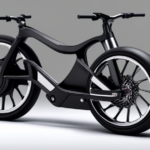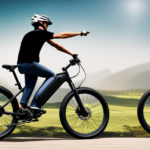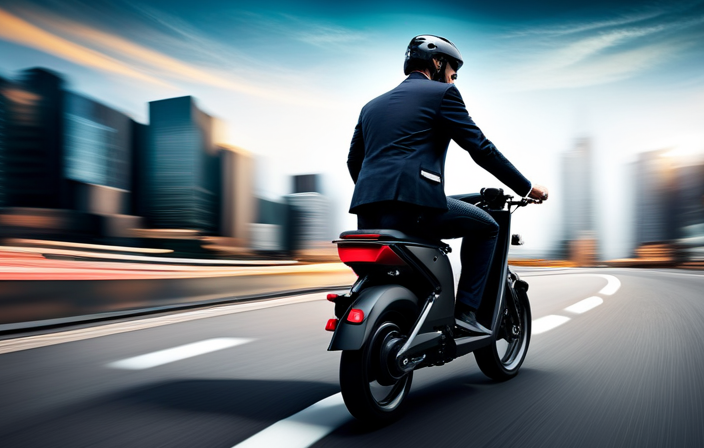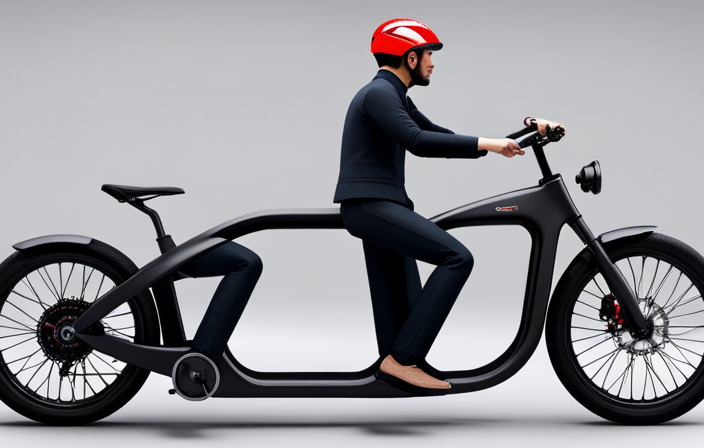Did you know that the average lifespan of an electric bike is around 3-5 years?
As an experienced electric bike enthusiast, I understand the importance of knowing how long these bikes can last.
In this article, we will dive into the various factors that contribute to the lifespan of an electric bike.
From the quality of the battery to motor performance and user care, we will explore all the key elements that can extend the lifespan of your electric bike.
So, let’s get started and ensure your electric bike lasts for years to come.
Key Takeaways
- Proper protection and storage can prolong the lifespan of an electric bike, including using a wall-mounted rack, applying a protective coating, and utilizing a dedicated bike storage shed.
- Consider weight capacity and load to maintain balanced weight distribution and prevent strain on components, adhering to manufacturer’s weight limits.
- Manufacturer warranty and support are important factors to consider, including the extent of warranty coverage, technical assistance, and availability of replacement parts.
- Environmental factors, riding style, and user care also impact the lifespan of an electric bike, including the impact of extreme temperatures, exposure to rain and snow, mindful riding style, and proper care and handling of the e-bike.
Understanding the Components of an Electric Bike
Understanding the components of an electric bike will help you determine how long it will last. As an experienced electric bike enthusiast, I can tell you that there are key components that play a crucial role in the lifespan of an e-bike.
First and foremost, understanding e-bike components such as the motor, battery, and controller is vital. These components work together to provide power and control to the bike. Regular maintenance of these components is crucial to ensure their longevity. Common maintenance issues include checking for loose connections, cleaning and lubricating the motor, and monitoring the battery’s performance.
Additionally, keeping the bike clean and protected from extreme weather conditions will also contribute to its lifespan.
Now, let’s delve into the next section and discuss the quality of the battery.
The Quality of the Battery
The battery’s quality directly impacts the lifespan of an e-bike. A high-quality battery will have a larger capacity, allowing for longer rides without needing to be recharged. On the other hand, a low-quality battery with a smaller capacity will require more frequent charging, reducing the overall lifespan of the bike.
Additionally, the charging time of the battery is also an important factor to consider. A battery that charges quickly will provide convenience and flexibility to the rider, while a battery with a long charging time can be frustrating and limit the usability of the bike.
Understanding the battery’s capacity and charging time is crucial in determining how long an e-bike will last.
Now, let’s delve into the topic of battery lifespan and charging cycles.
Battery Lifespan and Charging Cycles
To determine the lifespan of your e-bike battery, you should consider the number of charging cycles it can handle and how it affects its overall performance. Battery lifespan depends on various factors, including battery maintenance and optimizing charging habits.
Here are three important points to keep in mind:
-
Avoid overcharging: Overcharging can degrade the battery’s lifespan. It is essential to unplug the charger once the battery is fully charged.
-
Charge regularly: Regular charging is beneficial for the battery’s health. It is recommended to charge the battery at least once every few weeks, even if you’re not using the e-bike regularly.
-
Store properly: When storing the e-bike for an extended period, ensure the battery is charged to around 50%. This helps prevent deep discharge and maintains battery longevity.
Understanding battery maintenance and optimizing charging habits can significantly extend the lifespan of your e-bike battery.
Now, let’s delve into the next section about motor efficiency and performance.
Motor Efficiency and Performance
Charging regularly and storing the battery properly can significantly increase the lifespan of your e-bike battery. However, it’s also important to consider the motor efficiency and performance to ensure a long-lasting electric bike. The motor is the heart of the e-bike, responsible for providing power and determining how well the bike performs. By optimizing motor efficiency, you can improve the overall performance of your electric bike. This can be achieved through various methods such as reducing friction, improving heat dissipation, and using high-quality components. Additionally, regular maintenance and servicing play a crucial role in keeping the motor running smoothly and efficiently. Proper lubrication, belt tension adjustment, and regular cleaning can all contribute to the longevity of the motor. Transitioning to the next section, maintenance and regular servicing are essential to ensure the continued performance and durability of your electric bike.
Maintenance and Regular Servicing
Make sure you regularly maintain and service your e-bike to keep it running smoothly and ensure its durability. Here are some maintenance tips to help you prolong the lifespan of your electric bike:
-
Clean your bike regularly: Dirt and debris can accumulate on the bike, affecting its performance. Use a mild detergent and water to clean the frame, wheels, and other components.
-
Check the tire pressure: Proper tire pressure not only improves the bike’s efficiency but also enhances its handling and reduces the risk of flats.
-
Inspect the brakes and gears: Ensure that the brake pads are not worn out and that the gears shift smoothly. Adjust or replace them as necessary.
Common issues to watch out for include battery degradation, loose connections, and worn-out chains. By addressing these issues promptly and following regular maintenance, you can keep your e-bike in optimal condition for longer.
Transitioning to the next section, riding conditions and terrain can also impact the longevity of your electric bike.
Riding Conditions and Terrain
When riding your e-bike, consider the conditions and terrain you encounter as they can impact the overall performance and lifespan of your electric bike.
Your riding technique plays a crucial role in determining how long your e-bike will last. Smooth and controlled riding, avoiding sudden acceleration or hard braking, can help reduce strain on the motor and battery, prolonging their lifespan.
Additionally, the impact of weather should not be underestimated. Riding in extreme heat or cold can affect the battery performance, causing it to drain faster or reduce its capacity. Wet and muddy conditions can also lead to accelerated wear and tear on the bike’s components. Therefore, it is important to adjust your riding style accordingly and take extra care when riding in challenging weather conditions.
As we transition into the next section about the frequency and duration of use, it is essential to understand how these factors can further influence the longevity of your electric bike.
Frequency and Duration of Use
When it comes to the longevity of an electric bike, the frequency and duration of use play a crucial role. The more frequently you use your electric bike, the faster its components will wear out. This is especially true for the battery, as the frequency of charging can affect its lifespan. Additionally, the duration of your rides also impacts the overall wear and tear on the bike. Riding for extended periods without giving the bike a break can put strain on its motor and other parts.
In addition to usage, weather conditions can also have an impact on the lifespan of an electric bike. Extreme temperatures, such as excessive heat or cold, can affect the performance of the battery and other electrical components. Riding in heavy rain or snow can also expose the bike to moisture, which can lead to rust and other damages.
To ensure the longevity of your electric bike, it is important to consider the frequency of charging and the impact of weather conditions. However, proper storage and protection are also vital, as I will discuss in the subsequent section.
Proper Storage and Protection
Proper storage and protection are essential for maximizing the lifespan of an e-bike. By implementing effective protection methods and utilizing appropriate storage options, you can shield your electric bike from potential damage caused by external factors. Here is a visual representation of some recommended protection methods and storage options:
| Protection Methods | Storage Options |
|---|---|
| Invest in a durable bike cover | Store in a dry and temperature-controlled environment |
| Use a secure bike lock | Hang the e-bike on a wall-mounted rack |
| Apply a protective coating to the frame | Utilize a dedicated bike storage shed |
Implementing these protection methods and storage options will help safeguard your e-bike from the elements, theft, and other potential risks. This will ultimately contribute to prolonging its lifespan. Considering the weight capacity and load of your electric bike is the next crucial step in ensuring optimal performance and durability.
Weight Capacity and Load
When it comes to prolonging the lifespan of an electric bike, proper storage and protection play a vital role. However, another crucial factor to consider is the weight capacity and load that the bike can handle.
As an experienced rider, I understand the importance of maintaining a balanced weight distribution on the bike to avoid putting excessive strain on its components. Manufacturers conduct extensive durability testing to determine the maximum weight capacity of their electric bikes. It is essential to adhere to these weight limits to ensure optimal performance and longevity.
By following these guidelines, you can prevent undue stress on the frame, motor, and battery, ultimately extending the life of your electric bike.
Now, let’s delve into the next section about manufacturer warranty and support, which further contributes to the overall lifespan of an electric bike.
Manufacturer Warranty and Support
The manufacturer’s warranty and support are crucial factors in ensuring the overall lifespan and performance of an e-bike. When purchasing an electric bike, it is essential to consider the level of manufacturer support and the extent of warranty coverage offered.
A reliable manufacturer will provide comprehensive support, including technical assistance, maintenance guidance, and prompt response to any issues or concerns. Additionally, a solid warranty can provide peace of mind, as it covers potential defects or malfunctions that may arise during the specified period.
With proper manufacturer support and warranty coverage, you can have confidence in the durability and longevity of your electric bike. This support also facilitates easy upgrading and replacing of parts when necessary, ensuring your e-bike remains in optimal condition for years to come.
Upgrading and Replacing Parts
When it comes to electric bikes, it’s important to consider the options for upgrading and replacing parts. As an experienced rider, I know that over time, certain components may wear out or become outdated.
The great thing about electric bikes is that they offer a wide range of upgrading options to enhance performance and customize your ride to your specific needs. Whether it’s upgrading the battery for longer range or replacing the brakes for better stopping power, there are plenty of choices available.
Common replacements include tires, chains, and pedals, which can easily be swapped out for improved versions. However, it’s important to note that not all electric bikes are created equal, and the availability of replacement parts may vary depending on the manufacturer.
Now, let’s dive into the environmental factors and climate that can impact the lifespan of an electric bike.
Environmental Factors and Climate
To maximize the lifespan of your electric bike, it’s crucial to consider the impact of environmental factors and climate. Climate change and weather patterns can significantly affect the durability and performance of your electric bike.
Extreme temperatures, such as excessive heat or cold, can have detrimental effects on the battery life and overall functioning of the bike. In extremely hot conditions, the battery may degrade faster, while freezing temperatures can reduce its efficiency.
Additionally, exposure to heavy rain or snow can lead to rusting and corrosion of the bike’s components. It’s important to store your electric bike in a dry and controlled environment when not in use to minimize these risks.
Understanding how different climate conditions can impact your electric bike will help you take necessary precautions and ensure its longevity.
When considering the impact of riding style and speed, it’s important to be mindful of the stress these factors can put on your electric bike’s components.
Impact of Riding Style and Speed
Your riding style and speed can greatly affect the performance and durability of your e-bike. Proper riding techniques and battery management are crucial to ensure the longevity of your electric bike. When it comes to riding style, aggressive and fast riding can put a strain on the motor and battery, causing them to wear out more quickly. On the other hand, a smooth and consistent riding style can help preserve the components and extend the lifespan of your e-bike. Additionally, managing the battery properly by avoiding complete discharge and charging it regularly can also contribute to the overall lifespan of your electric bike. By being mindful of your riding style and implementing effective battery management techniques, you can maximize the lifespan of your e-bike. This leads us to the next section on user care and handling, where we will discuss further steps to ensure the longevity of your electric bike.
User Care and Handling
Taking proper care of and handling your e-bike is essential for maximizing its lifespan. User training is an important aspect of ensuring that your electric bike lasts as long as possible.
It is crucial to educate yourself on how to operate the bike safely and efficiently. This includes learning how to properly use the different modes and features of the bike, understanding the battery charging process, and knowing how to perform basic maintenance tasks.
Safety precautions should also be followed, such as wearing appropriate protective gear and obeying traffic laws.
By taking the time to learn and implement these user care and handling practices, you can significantly extend the life of your electric bike.
Now, let’s move on to some tips for extending the lifespan of your e-bike without compromising its performance.
Tips for Extending the Lifespan of Your Electric Bike
One way to ensure your e-bike has a longer lifespan is by implementing regular maintenance and inspections. Electric bike maintenance is crucial for increasing the lifespan of your bike and maximizing performance. Here are some tips to help you extend the lifespan of your electric bike:
- Keep your e-bike clean and dry to prevent rust and corrosion.
- Regularly check and tighten all bolts and screws to ensure they are secure.
- Inspect the tires for wear and tear and replace them when necessary.
- Keep the battery charged within the recommended voltage range and avoid overcharging.
By following these maintenance tips, you can increase the lifespan of your electric bike and enjoy years of reliable and efficient performance. Remember, proper care and attention are essential for maintaining the longevity of your e-bike.
Frequently Asked Questions
Can I ride my electric bike in the rain?
Yes, you can ride an electric bike in the rain. However, it’s important to take certain maintenance precautions. Ensure your bike is properly sealed, wipe it down after each ride, and regularly check and lubricate the chain.
How often should I clean and lubricate the chain on my electric bike?
I clean and lubricate the chain on my electric bike every 100-200 miles to ensure optimal performance. Regular chain maintenance is essential for smooth and efficient operation, reducing wear and extending the lifespan of the bike.
Can I take my electric bike on public transportation?
Yes, you can take your electric bike on public transportation. However, you should consider the electric bike weight when carrying it. Ensure there is proper storage available to secure the bike during transit.
Are there any special safety precautions I should take when riding an electric bike?
When riding an electric bike, it is important to prioritize safety. Make sure to wear proper safety gear, such as a helmet and reflective clothing. Additionally, regular electric bike maintenance is crucial to ensure safe and reliable operation.
Can I use my electric bike for commuting long distances?
I can use my electric bike for commuting long distances. With proper electric bike battery life management and regular electric bike maintenance, I can ensure that my bike is reliable and efficient for my daily commute.
Conclusion
In conclusion, an electric bike is not just a means of transportation. It’s a companion that can accompany you on countless unforgettable journeys.
With proper care and maintenance, its lifespan can extend beyond your expectations. Picture this: cruising through the countryside, feeling the wind in your hair as your trusty electric bike effortlessly glides along.
Its components, from the high-quality battery to the efficient motor, work harmoniously to ensure a smooth and exhilarating ride. So, invest in the longevity of your electric bike and let it take you on endless adventures.
















